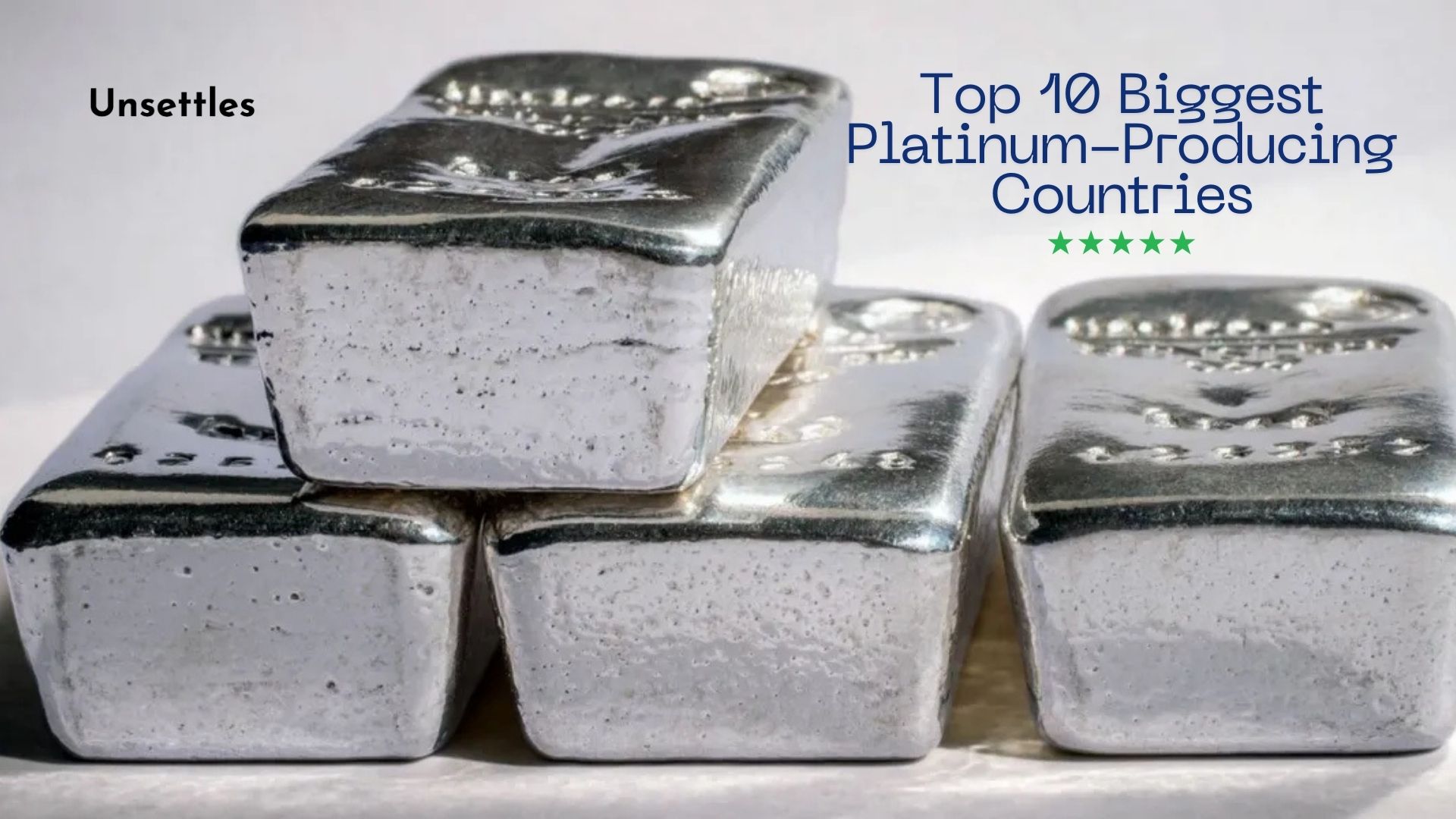Biggest Platinum-Producing Countries: Platinum is a highly valuable metal, known for its durability, resistance to corrosion, and versatility. It is essential in various industries, from automotive to jewelry and electronics. In 2024, the global platinum production landscape is shaped by a few key countries, each contributing significantly to the supply chain. South Africa leads the way, with other countries like Russia and Zimbabwe following closely, each with unique production strategies and resources. Let’s explore the top 10 platinum producers for 2024 and what makes them stand out.
1. South Africa – 130,000 kg of Platinum
South Africa is the world’s largest producer of platinum, with a staggering 130,000 kilograms annually. The Bushveld Igneous Complex, rich in platinum reserves, is central to the country’s output. Advanced mining technology and a well-established infrastructure make South Africa a powerhouse in platinum production. Biggest Platinum-Producing Countries
South Africa’s strength lies in its resources and mining efficiency. With a focus on advanced extraction methods and a vast network of platinum mines, the country has maintained its position as the top global supplier, meeting the increasing demand for platinum worldwide.
2. Russia – 22,000 kg of Platinum
Russia ranks second globally, producing 22,000 kilograms of platinum each year. Russian platinum often comes as a byproduct of nickel and copper mining, which is highly efficient for maximizing mineral extraction. This integrated approach allows Russia to maintain a strong presence in the platinum market.
The country’s resource management strategies emphasize efficiency, resource optimization, and sustainability, which have solidified Russia’s role as a significant global platinum supplier. Biggest Platinum-Producing Countries
3. Zimbabwe – 15,000 kg of Platinum
Zimbabwe produces 15,000 kilograms of platinum annually, making it the third-largest producer worldwide. The Great Dyke geological formation holds the country’s extensive platinum reserves, positioning Zimbabwe as a key player in the global platinum supply chain.
Zimbabwe’s mining sector has been crucial to its economy, generating employment and supporting technological advancements. This has allowed the country to establish a stable presence in the global platinum market. Biggest Platinum-Producing Countries
4. Canada – 7,400 kg of Platinum
Canada ranks fourth with a production of 7,400 kilograms annually. The Lac des Îles Mine in Ontario is the primary source of Canadian platinum. With a focus on efficient mining practices and environmental responsibility, Canada has become a trusted global supplier of platinum.
Canada’s platinum mining industry is known for using cutting-edge technology, ensuring operational efficiency and sustainability.
5. United States – 4,200 kg of Platinum
The United States produces 4,200 kilograms of platinum annually, primarily from the Stillwater Mining Company in Montana. The U.S. meets its platinum demand through both primary production and recycling, demonstrating a commitment to resource optimization and sustainability.
By balancing new production with recycling efforts, the U.S. platinum industry supports both the national and global supply. Biggest Platinum-Producing Countries
6. China – 2,500 kg of Platinum
China produces 2,500 kilograms of platinum each year. The growing industrial demand for platinum has driven China’s mining efforts, contributing to the country’s increasing significance in the platinum market.
China’s strategic focus on platinum production supports both domestic needs and the international supply chain, enhancing its position as a rising player in the global market.
7. Finland – 764 kg of Platinum
Finland produces 764 kilograms of platinum annually, largely as a byproduct of its nickel mining operations. Finland’s commitment to ethical and sustainable mining practices aligns with global environmental standards, making it a respected platinum producer.
Finland’s approach highlights resource efficiency by maximizing the output of both platinum and nickel.
8. Colombia – 832 kg of Platinum
Colombia’s platinum industry is based on primary production and recycling, with an output of 832 kilograms annually. This diversified approach helps Colombia meet both local and international demand.
Colombia’s growing platinum industry has established the country as a dependable player in the global market. Biggest Platinum-Producing Countries
9. Australia – 100 kg of Platinum
Australia, producing 100 kilograms of platinum annually, may have a smaller output, but its contribution to the global market remains valuable. Most of Australia’s platinum is sourced from operations in collaboration with the U.S.-based Stillwater Mining Company.
Despite its smaller scale, Australia is a consistent platinum supplier due to its efficient mining practices and partnerships.
10. Poland – 90 kg of Platinum
Poland rounds out the top 10 with an annual production of 90 kilograms. Polish platinum is a byproduct of copper mining, demonstrating efficient resource utilization and adding value to the country’s mining sector. Biggest Platinum-Producing Countries
Poland’s contribution underscores the importance of platinum in the global supply chain, even in smaller quantities.
Conclusion
In 2024, the top Biggest Platinum-Producing Countries demonstrate a blend of resource wealth, mining efficiency, and sustainability. South Africa leads with its vast reserves, while countries like Russia, Zimbabwe, and Canada contribute significantly to the global supply chain. Together, these nations meet the demand for platinum across various industries and maintain the metal’s status as a valuable resource worldwide.
FAQs about Biggest Platinum-Producing Countries
What makes South Africa the leading platinum producer?
South Africa’s platinum production is driven by the mineral-rich Bushveld Igneous Complex and advanced mining technology, allowing the country to meet global demand consistently.
How does Russia produce platinum as a byproduct?
In Russia, platinum is often obtained as a byproduct of nickel and copper mining, maximizing resource extraction and adding value to the country’s mining sector.
Why is Zimbabwe’s Great Dyke significant for platinum production?
The Great Dyke formation in Zimbabwe is rich in platinum reserves, making it a central hub for mining and a key contributor to Zimbabwe’s economy.
What role does recycling play in U.S. platinum production?
The United States supplements primary platinum production with recycling, which supports sustainability and helps meet domestic demand without over-relying on new mining.
Is Finland’s platinum production sustainable?
Yes, Finland emphasizes ethical and sustainable mining practices, producing platinum primarily as a byproduct of nickel mining while adhering to international environmental standards.
